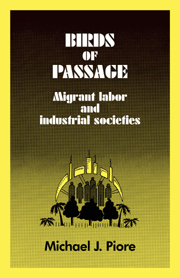Book contents
- Frontmatter
- Contents
- Preface
- 1 Introduction
- 2 The jobs
- 3 The migrants
- 4 Particular characteristics of the migrant labor market
- 5 The impact of migration on the place of origin
- 6 The historical evolution of long-distance migration in the United States
- 7 The dilemmas of current U.S. immigration policy
- Notes
- Bibliography
- Index
4 - Particular characteristics of the migrant labor market
Published online by Cambridge University Press: 28 October 2009
- Frontmatter
- Contents
- Preface
- 1 Introduction
- 2 The jobs
- 3 The migrants
- 4 Particular characteristics of the migrant labor market
- 5 The impact of migration on the place of origin
- 6 The historical evolution of long-distance migration in the United States
- 7 The dilemmas of current U.S. immigration policy
- Notes
- Bibliography
- Index
Summary
The characteristics of migrant workers outlined in the previous chapter give a particular cast to their behavior in the labor market. This, in turn, affects the structure and operation of the market and its evolution over time. At certain junctures it can produce results that are in conflict with conventional notions about how labor markets operate and about what parameters are important in evaluating the impact of migrant flows and attempting to control such flows for policy purposes. This chapter discusses such effects in four specific areas: the competition between migrants and other labor-force groups, wage determination, unemployment, and worker organization.
Migrants and other labor-force groups
At the heart of most discussions of migration policy lies the question of competition between migrants and native workers. On the one hand, it is argued that migrants take jobs from natives: The extreme version of this argument, not uncommon in the current policy debates in the United States and Western Europe, is that, were the migrants to leave, they would free enough jobs to absorb domestic unemployment. On the other hand is the argument that migrants are largely complementary to native workers and the migration process thus works to preserve native jobs and sustain native consumption patterns. At the heart of this position is the contention that migrants take jobs that native workers will not accept, and that by so doing they preserve industries and technologies that would otherwise move abroad or drop out of our consumption patterns as important sources of employment for native workers as well.
- Type
- Chapter
- Information
- Birds of PassageMigrant Labor and Industrial Societies, pp. 86 - 114Publisher: Cambridge University PressPrint publication year: 1979



